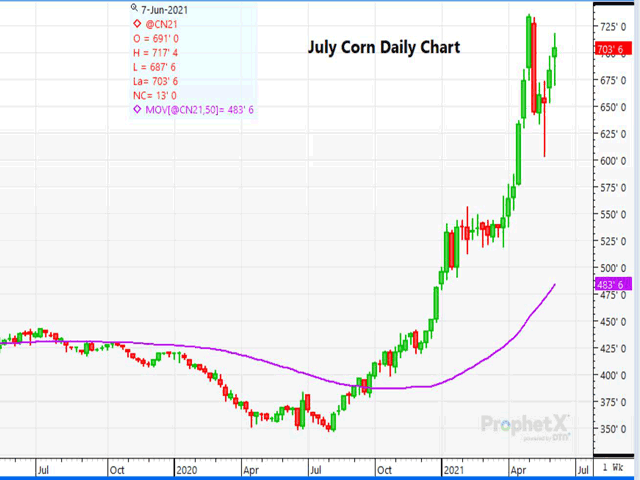USDA Reports Review
June USDA WASDE Report Bullish for Corn, as Expected
With many in the trade expecting slightly bullish corn numbers in the June 2021 World Agricultural Supply and Demand (WASDE) report, USDA did not disappoint. Rising export and domestic demand sent corn ending stocks lower than the trade had estimated. Wheat and soybeans were neutral to bearish, but, with the fall in crush and expanding carryout, U.S. spot bean futures took the brunt of selling, while new-crop November rose another 11 cents to near the highs.
CORN
Most traders and analysts entered the June WASDE report convinced that they would see a bullish result for corn, and USDA did not disappoint. They raised both U.S. corn exports and ethanol usage by 75 million bushels (mb) each. U.S. corn exports were pegged at a record-large 2.850 billion bushels (bb). The net effect was a lower-than-expected 2020-21 stocks number of 1.107 bb, compared to last month's 1.257 bb. With the lower carry in stocks and no change to the 2021-22 yield and production estimates, new-crop ending stocks fell to 1.357 bb.
Although corn conditions reflected a solid 72% good-to-excellent rating as of last week, the abnormally hot and dry start to June and the still-solid export and ethanol demand will likely reduce corn stocks even more in future reports.
On the world front, global ending stocks for 2020-21 fell to 280.6 million metric tons (mmt), about as expected and down nearly 3 mmt from May. For the 2021-22 season, ending stocks fell 3.9 mmt (less than expected) to 289.5 mmt (11.4 bb). Surprising was the very conservative estimate of 98.5 mmt (3.88 bb) for Brazilian production -- about 1.5 mmt higher than the average estimate and well above where most private analysts think (90 mmt to 95 mmt). We could see a future reduction in Brazil's final corn production and a resulting gain in U.S. export demand in future reports. Meanwhile, Argentina was left unchanged at 47 mmt (1.85 bb).
P[L1] D[0x0] M[300x250] OOP[F] ADUNIT[] T[]
July corn futures were trading nearly 15 cents higher prior to the release of the report, and at one point, rose 27 cents, but finished just 8 1/4 cents higher for the day.
SOYBEANS:
The report was not expected to hold much fanfare for soybeans, but USDA gave us a mild surprise by starting their own rationing program, as they lowered old-crop soy crush by 15 mb; that resulted in a higher-than-expected old-crop soybean carryout of 135 mb -- the first time in four months that ending stocks have changed from 120 mb. The extra 15 mb carried over into the new-crop season with an increase in 2021-22 ending stocks to 155 mb. With still very solid crush margins, the only explanation is an expected shortage of U.S. soybean supplies as we get into the summer months.
Soybean production was left unchanged at 4.405 bb, based on a 50.8 bushel-per-acre (bpa) yield.
On the global front, WASDE raised Brazilian soybean production to a record-large 137 mmt (5.03 bb) versus 136 mmt a month ago. Old-crop world ending stocks rose by 1.2 mmt to 88 mmt, while new-crop ending bean stocks moved up by 1.5 mmt to 92.6 mmt (3.4 bb) -- more than traders had expected. There were no changes made to China demand.
July soybean futures, trading right around unchanged prior to the report, fell sharply on the bearish implications of old-crop rationing and ideas that the June acreage report is likely to reflect higher acres planted. The July-November spread inverse narrowed by 30 cents on Thursday.
WHEAT:
USDA raised winter wheat production by 26 mb to 1.306 bb, while hard red winter wheat rose 40 mb to 771 mb (higher than trade expectations). Old-crop export demand was boosted by 20 mb to 985 mb, sending stocks to 852 mb -- about 16 mb below trade expectations. Feed and residual usage was raised by 10 mb in 2021-21 to 180 mb, sending new-crop ending stocks lower to 770 mb, down from 774 mb in May and down from the revised 852 mb last year. The ongoing severe drought in the spring wheat belt resulted in no decline in yield and production, which is likely to change in future reports as drought continues to cover much of the Northern Plains.
The global wheat balance sheet loosened up a bit as world production rose to a record-large 794.4 mmt (29.2 bb). European Union and Black Sea wheat crops were revised higher, with Russian wheat pegged at a new record-large 86 mmt (3.16 bb) compared to last year's 85.6 mmt. Ukraine was also raised by 500,000 metric tons to a record-large 29.5 mmt, and the EU wheat crop was raised by 3.5 mmt to 137.5 mmt (5.05 bb).
Kansas City wheat futures were trading up 5 cents prior to the report and finished up 4 1/2 cents -- probably a victory considering the neutral-to-bearish report.
Dana Mantini can be reached at dana.mantini@dtn.com
Follow Dana Mantini on Twitter @mantini_r
(c) Copyright 2021 DTN, LLC. All rights reserved.




